MGMT 1101: Improving Management Skills: Roles, Power & Leadership
VerifiedAdded on 2023/06/11
|14
|2836
|171
Report
AI Summary
This report discusses key management concepts, including Mintzberg's ten managerial roles (figurehead, leader, liaison, monitor, disseminator, spokesperson, entrepreneur, disturbance handler, resource allocator, and negotiator) and their practical application in a business setting. It also examines the five sources of power available to a leader: expert, positional, reward, coercive, and personal power, emphasizing their impact on leadership effectiveness. Furthermore, the report explores situational leadership, highlighting how different leadership styles (telling, selling, participating, and delegating) are appropriate for different levels of follower development (D1-D4), providing a comprehensive overview of essential management and leadership principles. The document is available on Desklib, a platform offering a wide range of study resources for students.
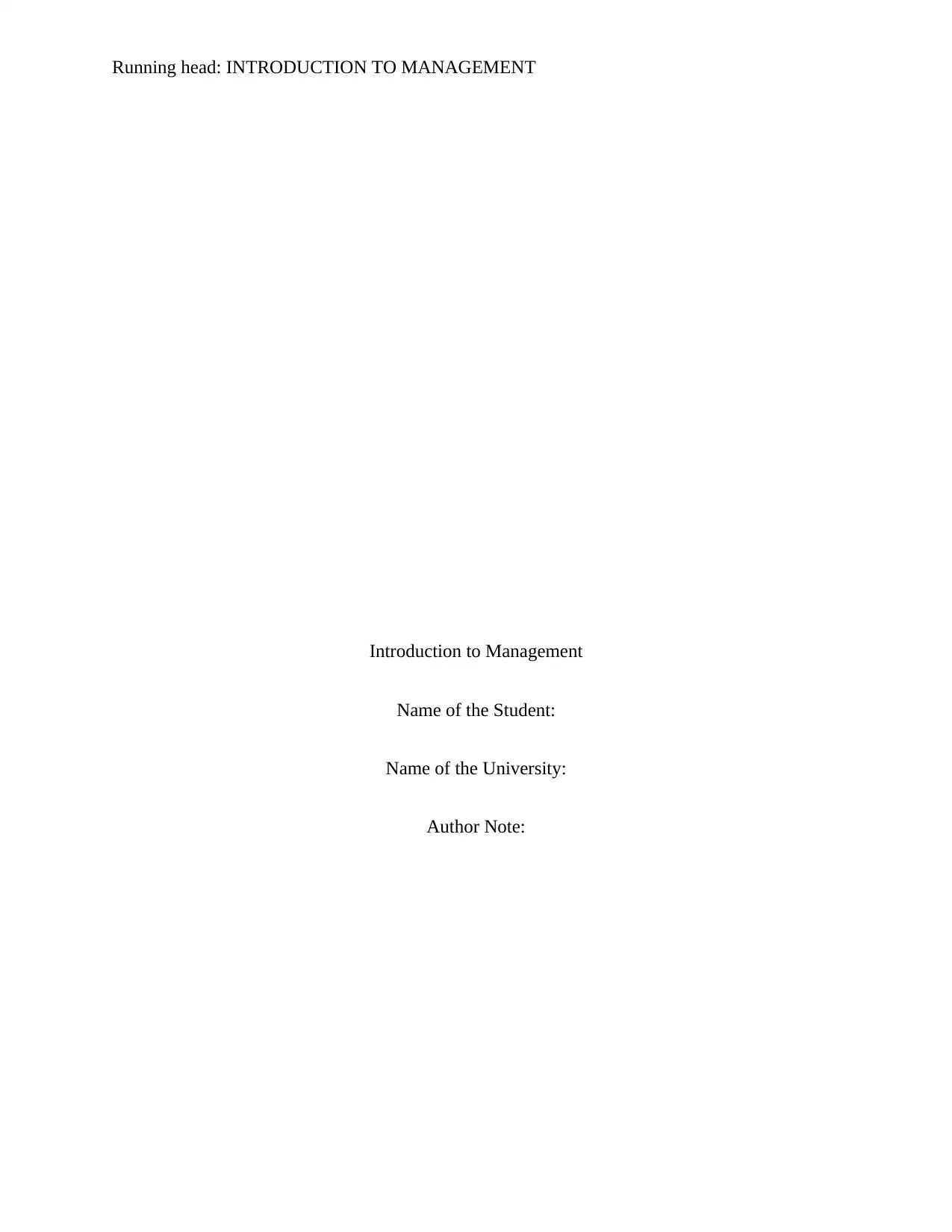
Running head: INTRODUCTION TO MANAGEMENT
Introduction to Management
Name of the Student:
Name of the University:
Author Note:
Introduction to Management
Name of the Student:
Name of the University:
Author Note:
Paraphrase This Document
Need a fresh take? Get an instant paraphrase of this document with our AI Paraphraser
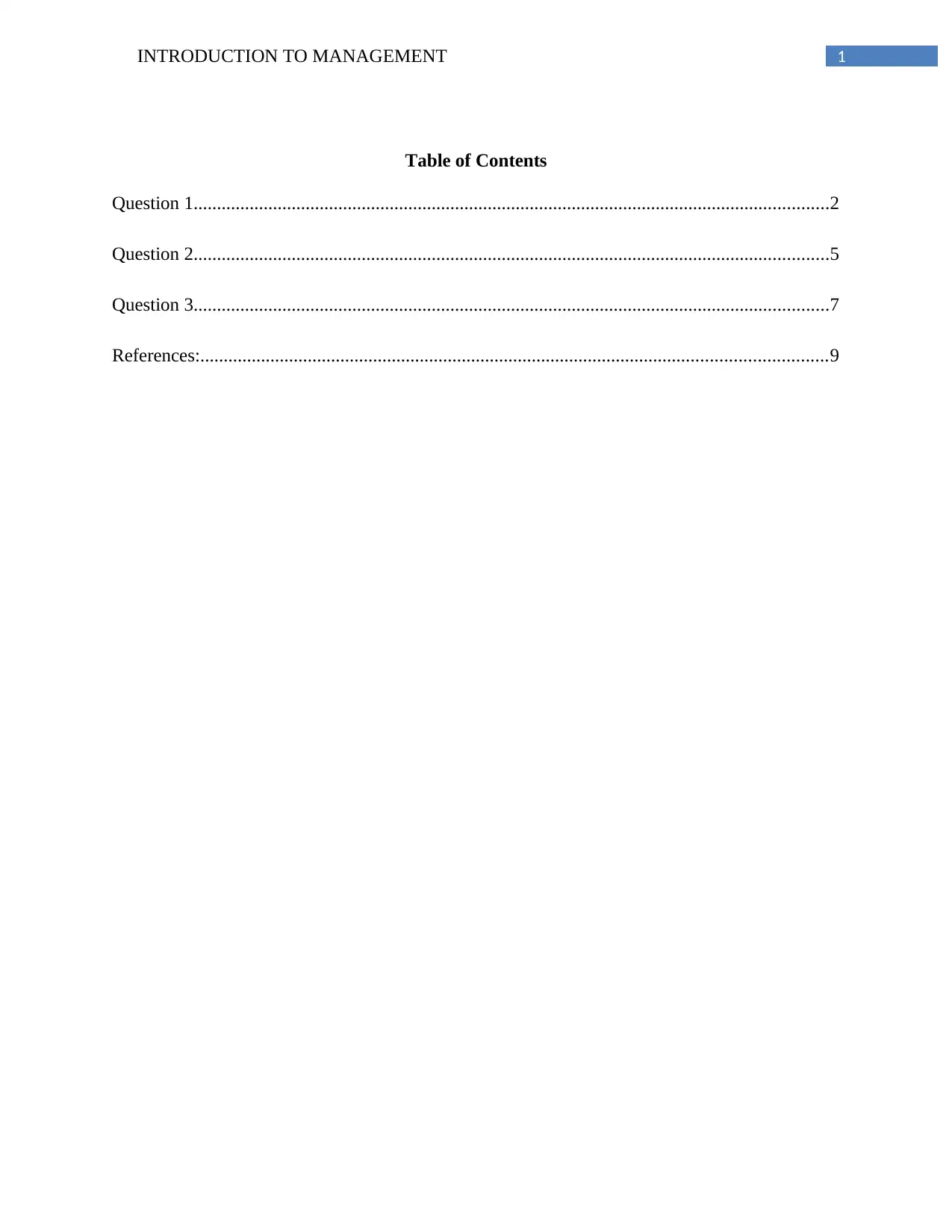
1INTRODUCTION TO MANAGEMENT
Table of Contents
Question 1........................................................................................................................................2
Question 2........................................................................................................................................5
Question 3........................................................................................................................................7
References:......................................................................................................................................9
Table of Contents
Question 1........................................................................................................................................2
Question 2........................................................................................................................................5
Question 3........................................................................................................................................7
References:......................................................................................................................................9
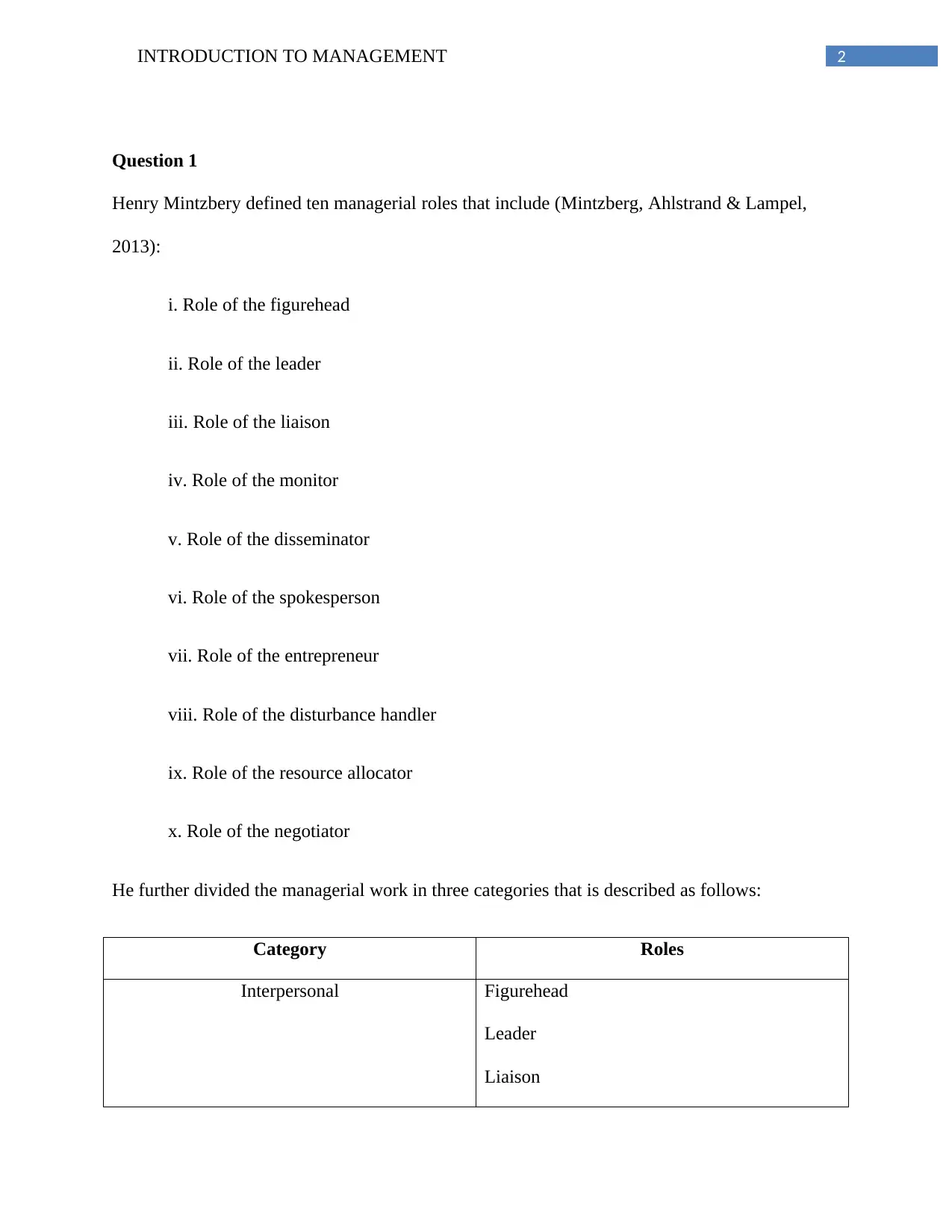
2INTRODUCTION TO MANAGEMENT
Question 1
Henry Mintzbery defined ten managerial roles that include (Mintzberg, Ahlstrand & Lampel,
2013):
i. Role of the figurehead
ii. Role of the leader
iii. Role of the liaison
iv. Role of the monitor
v. Role of the disseminator
vi. Role of the spokesperson
vii. Role of the entrepreneur
viii. Role of the disturbance handler
ix. Role of the resource allocator
x. Role of the negotiator
He further divided the managerial work in three categories that is described as follows:
Category Roles
Interpersonal Figurehead
Leader
Liaison
Question 1
Henry Mintzbery defined ten managerial roles that include (Mintzberg, Ahlstrand & Lampel,
2013):
i. Role of the figurehead
ii. Role of the leader
iii. Role of the liaison
iv. Role of the monitor
v. Role of the disseminator
vi. Role of the spokesperson
vii. Role of the entrepreneur
viii. Role of the disturbance handler
ix. Role of the resource allocator
x. Role of the negotiator
He further divided the managerial work in three categories that is described as follows:
Category Roles
Interpersonal Figurehead
Leader
Liaison
⊘ This is a preview!⊘
Do you want full access?
Subscribe today to unlock all pages.

Trusted by 1+ million students worldwide
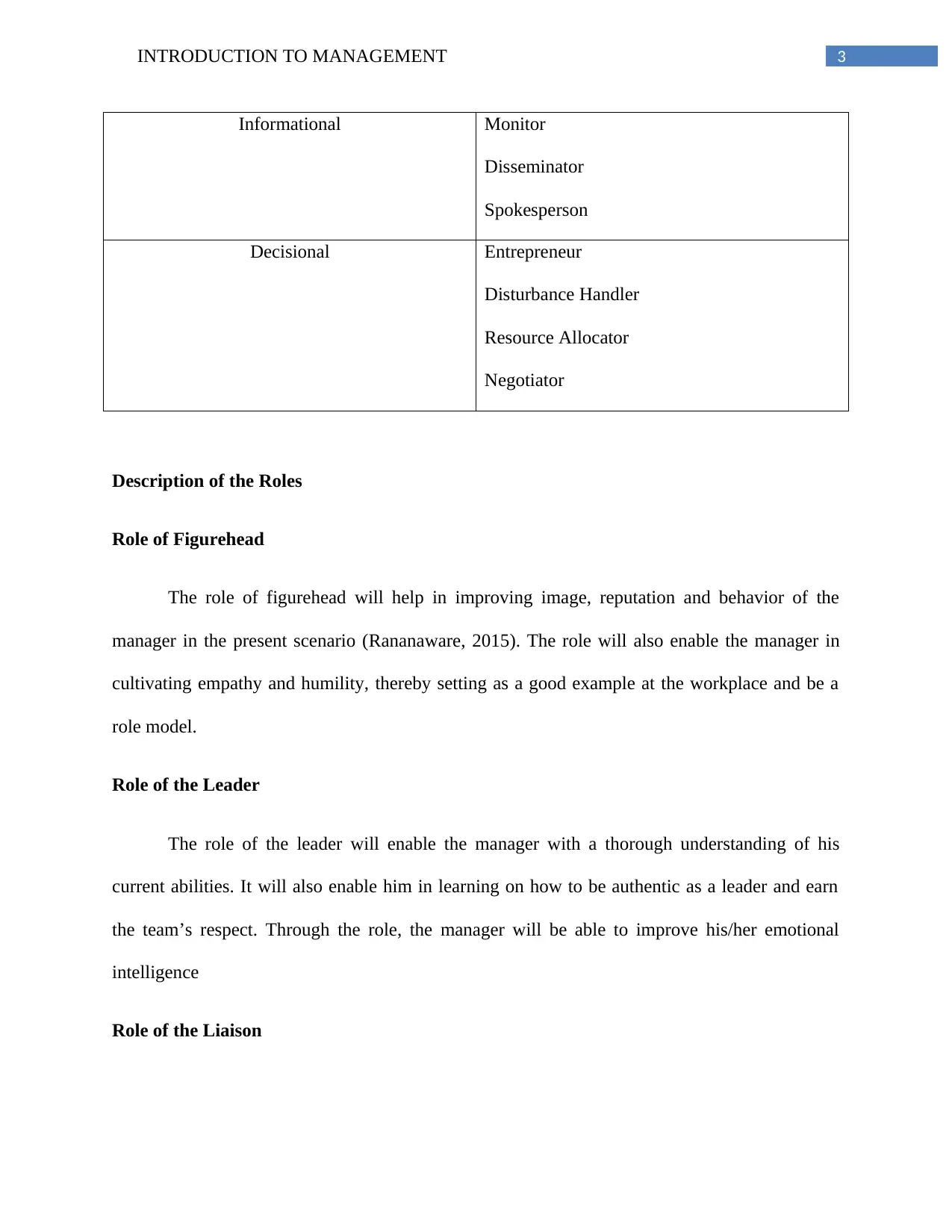
3INTRODUCTION TO MANAGEMENT
Informational Monitor
Disseminator
Spokesperson
Decisional Entrepreneur
Disturbance Handler
Resource Allocator
Negotiator
Description of the Roles
Role of Figurehead
The role of figurehead will help in improving image, reputation and behavior of the
manager in the present scenario (Rananaware, 2015). The role will also enable the manager in
cultivating empathy and humility, thereby setting as a good example at the workplace and be a
role model.
Role of the Leader
The role of the leader will enable the manager with a thorough understanding of his
current abilities. It will also enable him in learning on how to be authentic as a leader and earn
the team’s respect. Through the role, the manager will be able to improve his/her emotional
intelligence
Role of the Liaison
Informational Monitor
Disseminator
Spokesperson
Decisional Entrepreneur
Disturbance Handler
Resource Allocator
Negotiator
Description of the Roles
Role of Figurehead
The role of figurehead will help in improving image, reputation and behavior of the
manager in the present scenario (Rananaware, 2015). The role will also enable the manager in
cultivating empathy and humility, thereby setting as a good example at the workplace and be a
role model.
Role of the Leader
The role of the leader will enable the manager with a thorough understanding of his
current abilities. It will also enable him in learning on how to be authentic as a leader and earn
the team’s respect. Through the role, the manager will be able to improve his/her emotional
intelligence
Role of the Liaison
Paraphrase This Document
Need a fresh take? Get an instant paraphrase of this document with our AI Paraphraser
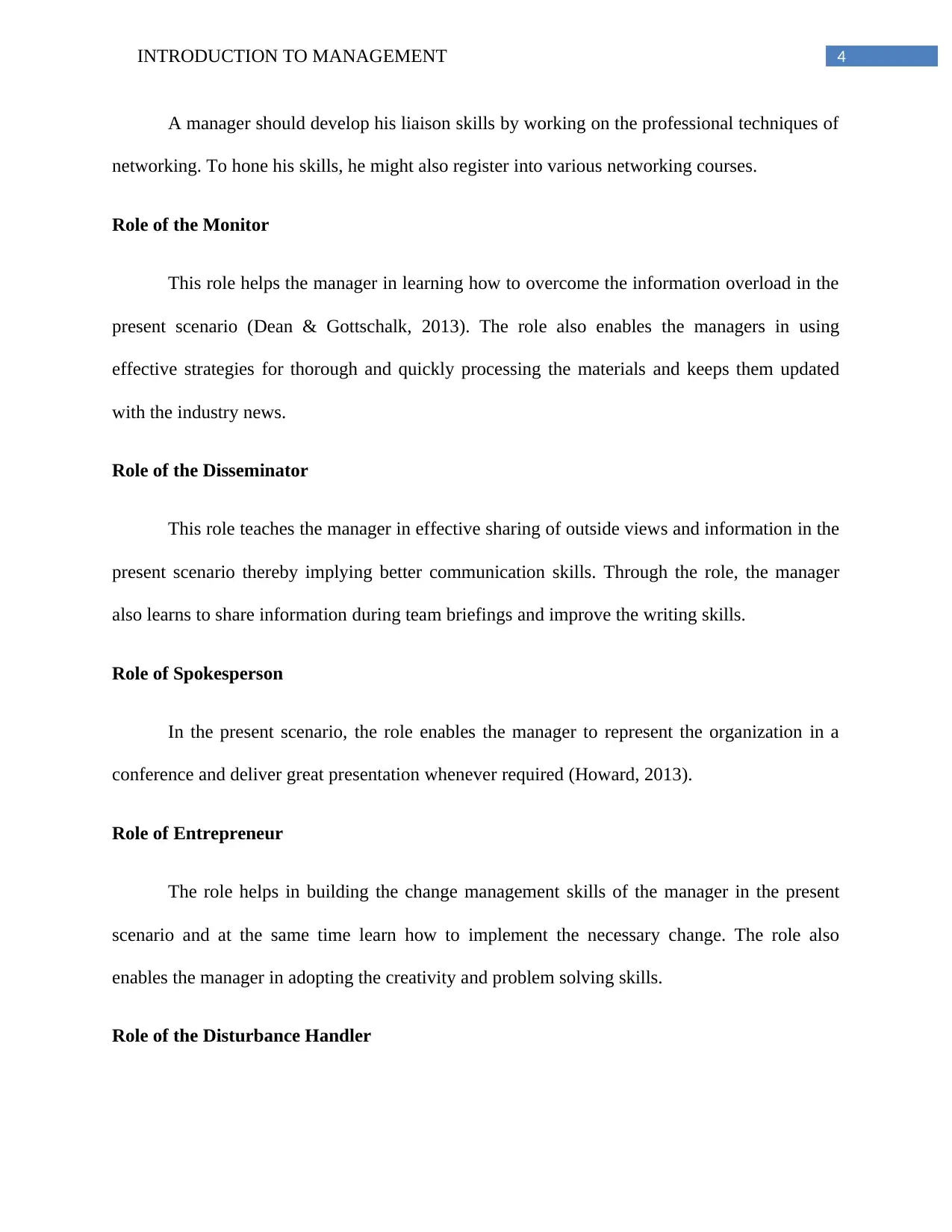
4INTRODUCTION TO MANAGEMENT
A manager should develop his liaison skills by working on the professional techniques of
networking. To hone his skills, he might also register into various networking courses.
Role of the Monitor
This role helps the manager in learning how to overcome the information overload in the
present scenario (Dean & Gottschalk, 2013). The role also enables the managers in using
effective strategies for thorough and quickly processing the materials and keeps them updated
with the industry news.
Role of the Disseminator
This role teaches the manager in effective sharing of outside views and information in the
present scenario thereby implying better communication skills. Through the role, the manager
also learns to share information during team briefings and improve the writing skills.
Role of Spokesperson
In the present scenario, the role enables the manager to represent the organization in a
conference and deliver great presentation whenever required (Howard, 2013).
Role of Entrepreneur
The role helps in building the change management skills of the manager in the present
scenario and at the same time learn how to implement the necessary change. The role also
enables the manager in adopting the creativity and problem solving skills.
Role of the Disturbance Handler
A manager should develop his liaison skills by working on the professional techniques of
networking. To hone his skills, he might also register into various networking courses.
Role of the Monitor
This role helps the manager in learning how to overcome the information overload in the
present scenario (Dean & Gottschalk, 2013). The role also enables the managers in using
effective strategies for thorough and quickly processing the materials and keeps them updated
with the industry news.
Role of the Disseminator
This role teaches the manager in effective sharing of outside views and information in the
present scenario thereby implying better communication skills. Through the role, the manager
also learns to share information during team briefings and improve the writing skills.
Role of Spokesperson
In the present scenario, the role enables the manager to represent the organization in a
conference and deliver great presentation whenever required (Howard, 2013).
Role of Entrepreneur
The role helps in building the change management skills of the manager in the present
scenario and at the same time learn how to implement the necessary change. The role also
enables the manager in adopting the creativity and problem solving skills.
Role of the Disturbance Handler
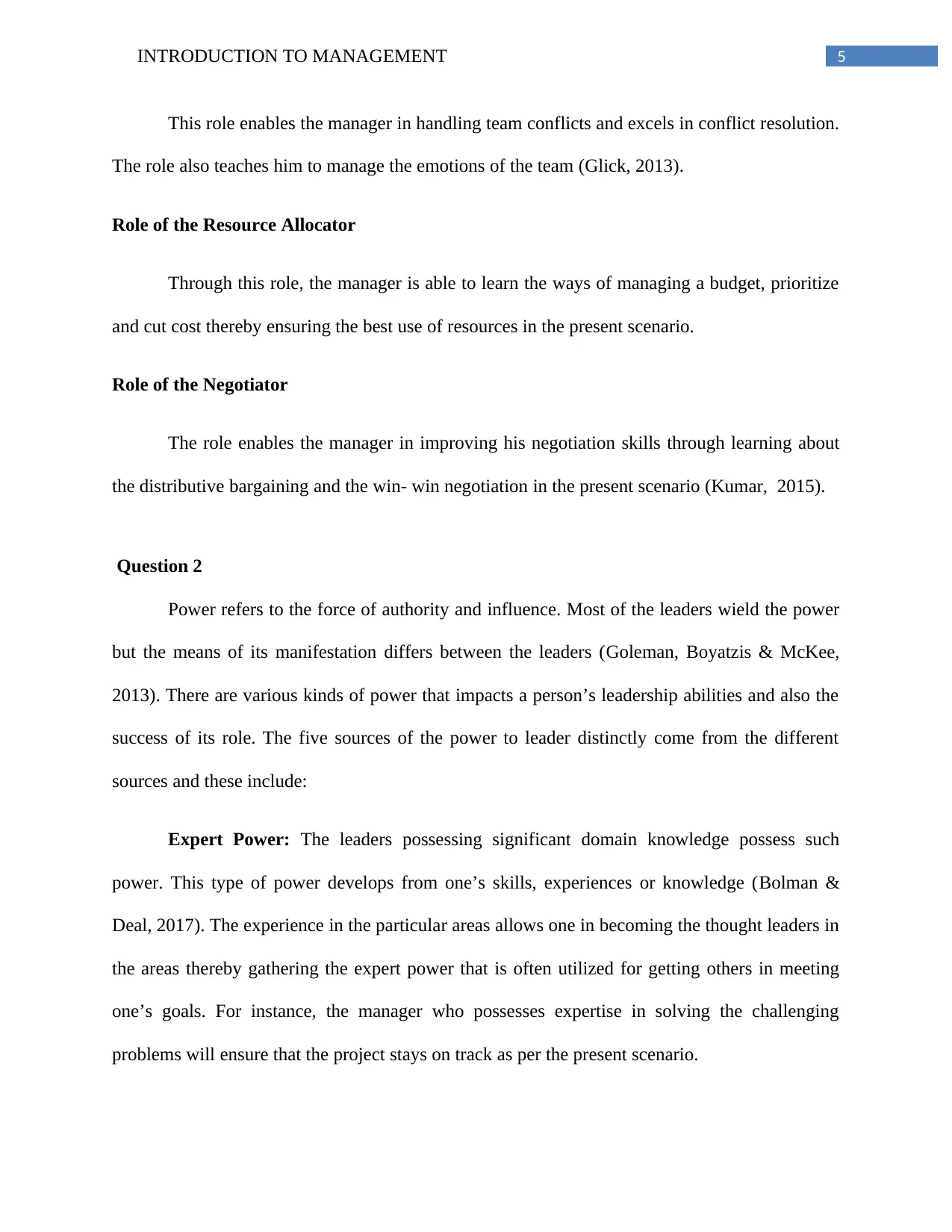
5INTRODUCTION TO MANAGEMENT
This role enables the manager in handling team conflicts and excels in conflict resolution.
The role also teaches him to manage the emotions of the team (Glick, 2013).
Role of the Resource Allocator
Through this role, the manager is able to learn the ways of managing a budget, prioritize
and cut cost thereby ensuring the best use of resources in the present scenario.
Role of the Negotiator
The role enables the manager in improving his negotiation skills through learning about
the distributive bargaining and the win- win negotiation in the present scenario (Kumar, 2015).
Question 2
Power refers to the force of authority and influence. Most of the leaders wield the power
but the means of its manifestation differs between the leaders (Goleman, Boyatzis & McKee,
2013). There are various kinds of power that impacts a person’s leadership abilities and also the
success of its role. The five sources of the power to leader distinctly come from the different
sources and these include:
Expert Power: The leaders possessing significant domain knowledge possess such
power. This type of power develops from one’s skills, experiences or knowledge (Bolman &
Deal, 2017). The experience in the particular areas allows one in becoming the thought leaders in
the areas thereby gathering the expert power that is often utilized for getting others in meeting
one’s goals. For instance, the manager who possesses expertise in solving the challenging
problems will ensure that the project stays on track as per the present scenario.
This role enables the manager in handling team conflicts and excels in conflict resolution.
The role also teaches him to manage the emotions of the team (Glick, 2013).
Role of the Resource Allocator
Through this role, the manager is able to learn the ways of managing a budget, prioritize
and cut cost thereby ensuring the best use of resources in the present scenario.
Role of the Negotiator
The role enables the manager in improving his negotiation skills through learning about
the distributive bargaining and the win- win negotiation in the present scenario (Kumar, 2015).
Question 2
Power refers to the force of authority and influence. Most of the leaders wield the power
but the means of its manifestation differs between the leaders (Goleman, Boyatzis & McKee,
2013). There are various kinds of power that impacts a person’s leadership abilities and also the
success of its role. The five sources of the power to leader distinctly come from the different
sources and these include:
Expert Power: The leaders possessing significant domain knowledge possess such
power. This type of power develops from one’s skills, experiences or knowledge (Bolman &
Deal, 2017). The experience in the particular areas allows one in becoming the thought leaders in
the areas thereby gathering the expert power that is often utilized for getting others in meeting
one’s goals. For instance, the manager who possesses expertise in solving the challenging
problems will ensure that the project stays on track as per the present scenario.
⊘ This is a preview!⊘
Do you want full access?
Subscribe today to unlock all pages.

Trusted by 1+ million students worldwide
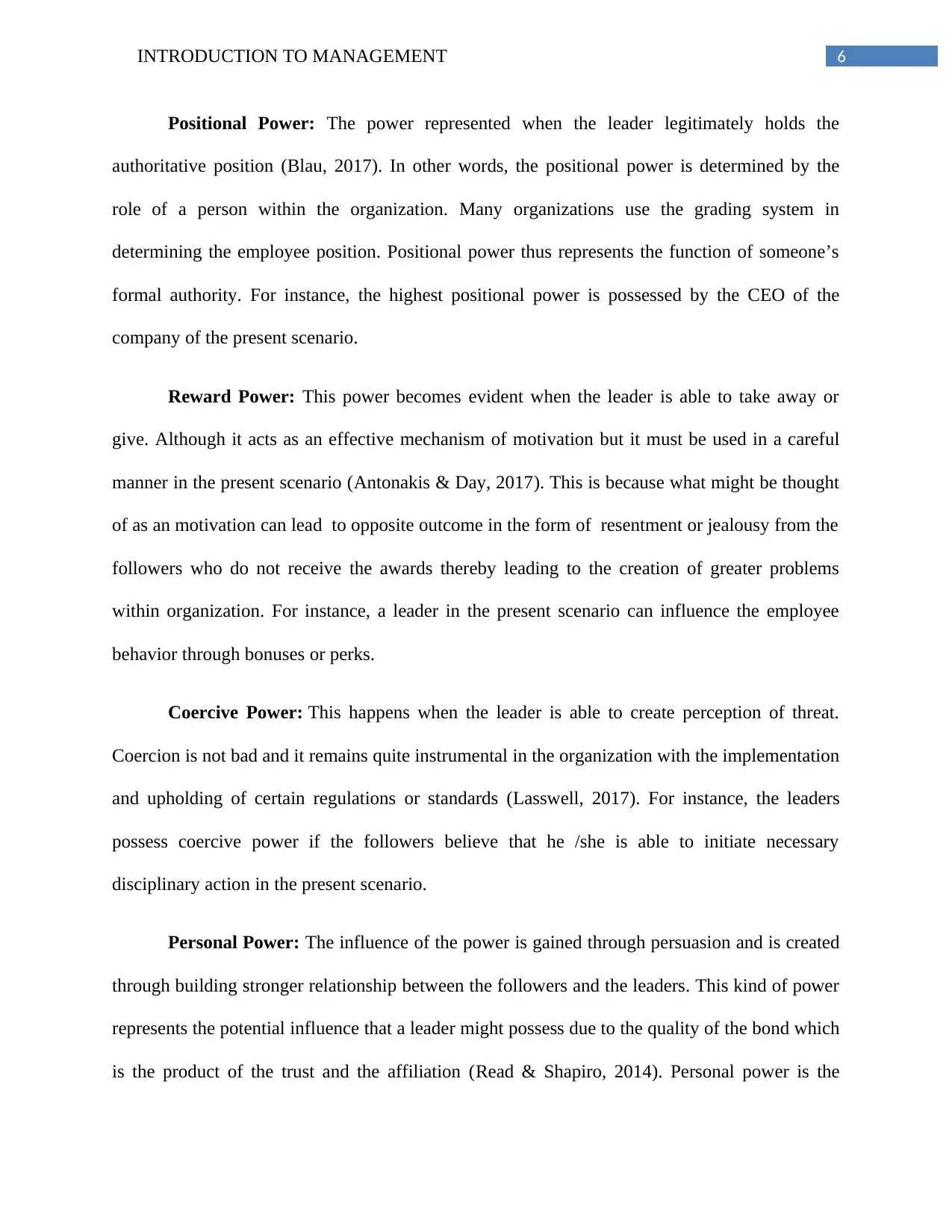
6INTRODUCTION TO MANAGEMENT
Positional Power: The power represented when the leader legitimately holds the
authoritative position (Blau, 2017). In other words, the positional power is determined by the
role of a person within the organization. Many organizations use the grading system in
determining the employee position. Positional power thus represents the function of someone’s
formal authority. For instance, the highest positional power is possessed by the CEO of the
company of the present scenario.
Reward Power: This power becomes evident when the leader is able to take away or
give. Although it acts as an effective mechanism of motivation but it must be used in a careful
manner in the present scenario (Antonakis & Day, 2017). This is because what might be thought
of as an motivation can lead to opposite outcome in the form of resentment or jealousy from the
followers who do not receive the awards thereby leading to the creation of greater problems
within organization. For instance, a leader in the present scenario can influence the employee
behavior through bonuses or perks.
Coercive Power: This happens when the leader is able to create perception of threat.
Coercion is not bad and it remains quite instrumental in the organization with the implementation
and upholding of certain regulations or standards (Lasswell, 2017). For instance, the leaders
possess coercive power if the followers believe that he /she is able to initiate necessary
disciplinary action in the present scenario.
Personal Power: The influence of the power is gained through persuasion and is created
through building stronger relationship between the followers and the leaders. This kind of power
represents the potential influence that a leader might possess due to the quality of the bond which
is the product of the trust and the affiliation (Read & Shapiro, 2014). Personal power is the
Positional Power: The power represented when the leader legitimately holds the
authoritative position (Blau, 2017). In other words, the positional power is determined by the
role of a person within the organization. Many organizations use the grading system in
determining the employee position. Positional power thus represents the function of someone’s
formal authority. For instance, the highest positional power is possessed by the CEO of the
company of the present scenario.
Reward Power: This power becomes evident when the leader is able to take away or
give. Although it acts as an effective mechanism of motivation but it must be used in a careful
manner in the present scenario (Antonakis & Day, 2017). This is because what might be thought
of as an motivation can lead to opposite outcome in the form of resentment or jealousy from the
followers who do not receive the awards thereby leading to the creation of greater problems
within organization. For instance, a leader in the present scenario can influence the employee
behavior through bonuses or perks.
Coercive Power: This happens when the leader is able to create perception of threat.
Coercion is not bad and it remains quite instrumental in the organization with the implementation
and upholding of certain regulations or standards (Lasswell, 2017). For instance, the leaders
possess coercive power if the followers believe that he /she is able to initiate necessary
disciplinary action in the present scenario.
Personal Power: The influence of the power is gained through persuasion and is created
through building stronger relationship between the followers and the leaders. This kind of power
represents the potential influence that a leader might possess due to the quality of the bond which
is the product of the trust and the affiliation (Read & Shapiro, 2014). Personal power is the
Paraphrase This Document
Need a fresh take? Get an instant paraphrase of this document with our AI Paraphraser
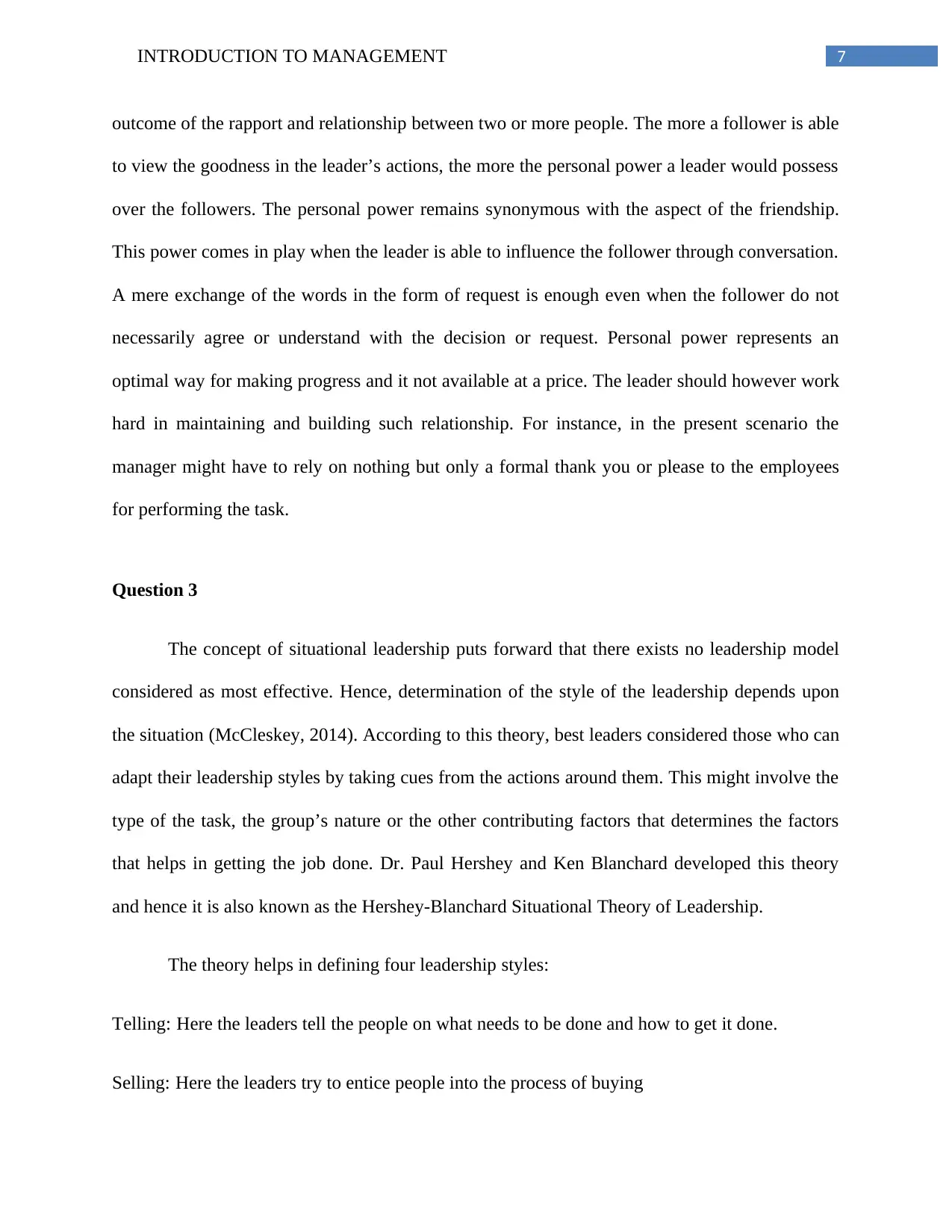
7INTRODUCTION TO MANAGEMENT
outcome of the rapport and relationship between two or more people. The more a follower is able
to view the goodness in the leader’s actions, the more the personal power a leader would possess
over the followers. The personal power remains synonymous with the aspect of the friendship.
This power comes in play when the leader is able to influence the follower through conversation.
A mere exchange of the words in the form of request is enough even when the follower do not
necessarily agree or understand with the decision or request. Personal power represents an
optimal way for making progress and it not available at a price. The leader should however work
hard in maintaining and building such relationship. For instance, in the present scenario the
manager might have to rely on nothing but only a formal thank you or please to the employees
for performing the task.
Question 3
The concept of situational leadership puts forward that there exists no leadership model
considered as most effective. Hence, determination of the style of the leadership depends upon
the situation (McCleskey, 2014). According to this theory, best leaders considered those who can
adapt their leadership styles by taking cues from the actions around them. This might involve the
type of the task, the group’s nature or the other contributing factors that determines the factors
that helps in getting the job done. Dr. Paul Hershey and Ken Blanchard developed this theory
and hence it is also known as the Hershey-Blanchard Situational Theory of Leadership.
The theory helps in defining four leadership styles:
Telling: Here the leaders tell the people on what needs to be done and how to get it done.
Selling: Here the leaders try to entice people into the process of buying
outcome of the rapport and relationship between two or more people. The more a follower is able
to view the goodness in the leader’s actions, the more the personal power a leader would possess
over the followers. The personal power remains synonymous with the aspect of the friendship.
This power comes in play when the leader is able to influence the follower through conversation.
A mere exchange of the words in the form of request is enough even when the follower do not
necessarily agree or understand with the decision or request. Personal power represents an
optimal way for making progress and it not available at a price. The leader should however work
hard in maintaining and building such relationship. For instance, in the present scenario the
manager might have to rely on nothing but only a formal thank you or please to the employees
for performing the task.
Question 3
The concept of situational leadership puts forward that there exists no leadership model
considered as most effective. Hence, determination of the style of the leadership depends upon
the situation (McCleskey, 2014). According to this theory, best leaders considered those who can
adapt their leadership styles by taking cues from the actions around them. This might involve the
type of the task, the group’s nature or the other contributing factors that determines the factors
that helps in getting the job done. Dr. Paul Hershey and Ken Blanchard developed this theory
and hence it is also known as the Hershey-Blanchard Situational Theory of Leadership.
The theory helps in defining four leadership styles:
Telling: Here the leaders tell the people on what needs to be done and how to get it done.
Selling: Here the leaders try to entice people into the process of buying
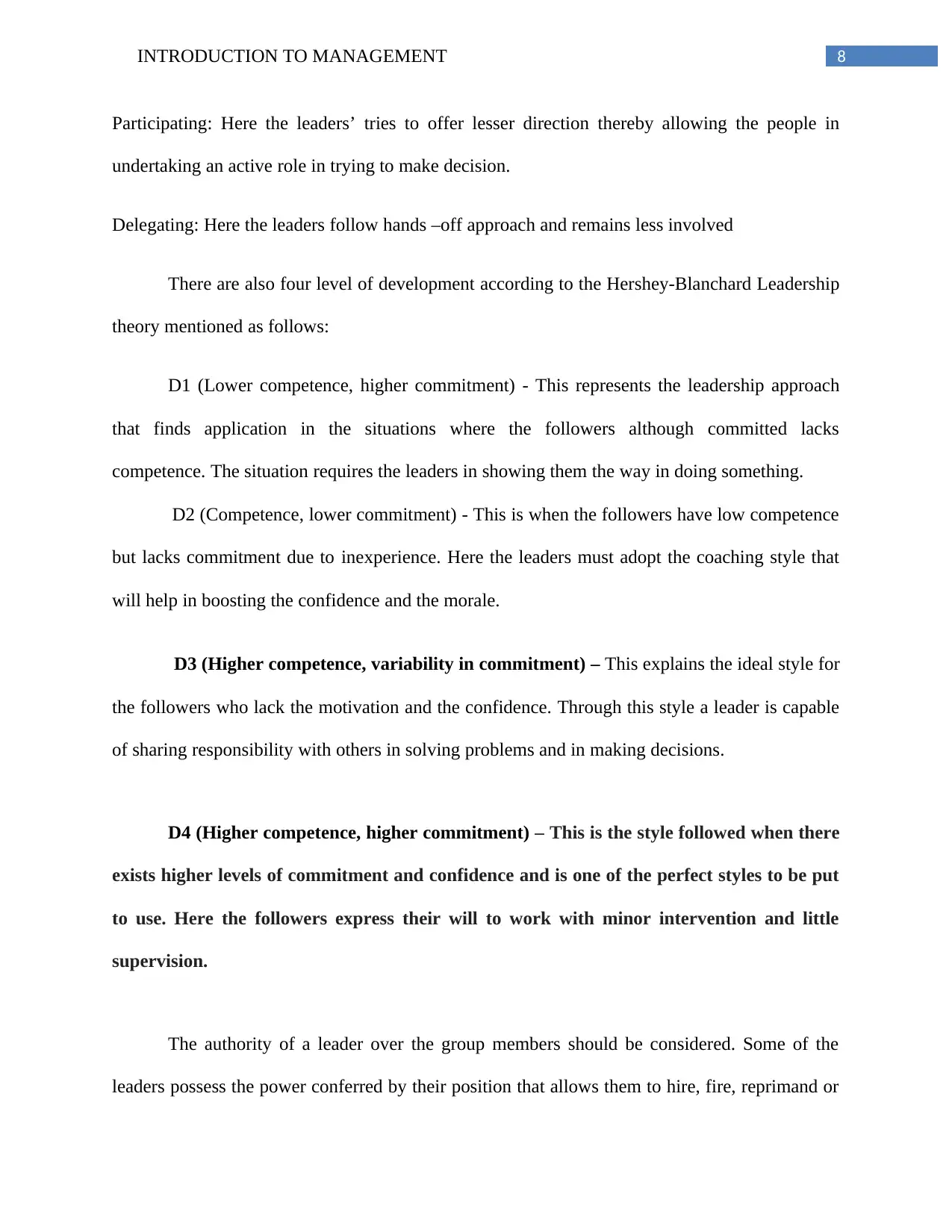
8INTRODUCTION TO MANAGEMENT
Participating: Here the leaders’ tries to offer lesser direction thereby allowing the people in
undertaking an active role in trying to make decision.
Delegating: Here the leaders follow hands –off approach and remains less involved
There are also four level of development according to the Hershey-Blanchard Leadership
theory mentioned as follows:
D1 (Lower competence, higher commitment) - This represents the leadership approach
that finds application in the situations where the followers although committed lacks
competence. The situation requires the leaders in showing them the way in doing something.
D2 (Competence, lower commitment) - This is when the followers have low competence
but lacks commitment due to inexperience. Here the leaders must adopt the coaching style that
will help in boosting the confidence and the morale.
D3 (Higher competence, variability in commitment) – This explains the ideal style for
the followers who lack the motivation and the confidence. Through this style a leader is capable
of sharing responsibility with others in solving problems and in making decisions.
D4 (Higher competence, higher commitment) – This is the style followed when there
exists higher levels of commitment and confidence and is one of the perfect styles to be put
to use. Here the followers express their will to work with minor intervention and little
supervision.
The authority of a leader over the group members should be considered. Some of the
leaders possess the power conferred by their position that allows them to hire, fire, reprimand or
Participating: Here the leaders’ tries to offer lesser direction thereby allowing the people in
undertaking an active role in trying to make decision.
Delegating: Here the leaders follow hands –off approach and remains less involved
There are also four level of development according to the Hershey-Blanchard Leadership
theory mentioned as follows:
D1 (Lower competence, higher commitment) - This represents the leadership approach
that finds application in the situations where the followers although committed lacks
competence. The situation requires the leaders in showing them the way in doing something.
D2 (Competence, lower commitment) - This is when the followers have low competence
but lacks commitment due to inexperience. Here the leaders must adopt the coaching style that
will help in boosting the confidence and the morale.
D3 (Higher competence, variability in commitment) – This explains the ideal style for
the followers who lack the motivation and the confidence. Through this style a leader is capable
of sharing responsibility with others in solving problems and in making decisions.
D4 (Higher competence, higher commitment) – This is the style followed when there
exists higher levels of commitment and confidence and is one of the perfect styles to be put
to use. Here the followers express their will to work with minor intervention and little
supervision.
The authority of a leader over the group members should be considered. Some of the
leaders possess the power conferred by their position that allows them to hire, fire, reprimand or
⊘ This is a preview!⊘
Do you want full access?
Subscribe today to unlock all pages.

Trusted by 1+ million students worldwide
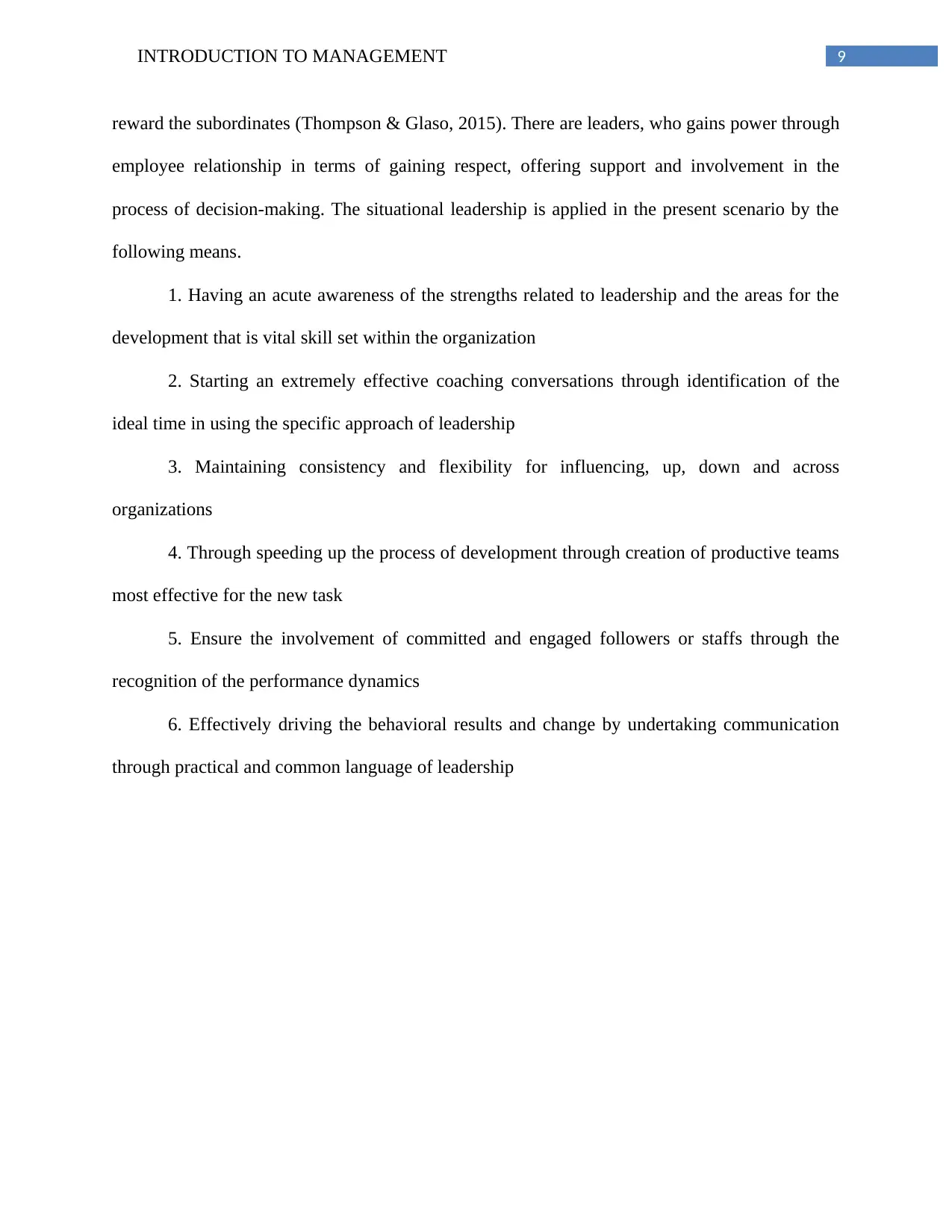
9INTRODUCTION TO MANAGEMENT
reward the subordinates (Thompson & Glaso, 2015). There are leaders, who gains power through
employee relationship in terms of gaining respect, offering support and involvement in the
process of decision-making. The situational leadership is applied in the present scenario by the
following means.
1. Having an acute awareness of the strengths related to leadership and the areas for the
development that is vital skill set within the organization
2. Starting an extremely effective coaching conversations through identification of the
ideal time in using the specific approach of leadership
3. Maintaining consistency and flexibility for influencing, up, down and across
organizations
4. Through speeding up the process of development through creation of productive teams
most effective for the new task
5. Ensure the involvement of committed and engaged followers or staffs through the
recognition of the performance dynamics
6. Effectively driving the behavioral results and change by undertaking communication
through practical and common language of leadership
reward the subordinates (Thompson & Glaso, 2015). There are leaders, who gains power through
employee relationship in terms of gaining respect, offering support and involvement in the
process of decision-making. The situational leadership is applied in the present scenario by the
following means.
1. Having an acute awareness of the strengths related to leadership and the areas for the
development that is vital skill set within the organization
2. Starting an extremely effective coaching conversations through identification of the
ideal time in using the specific approach of leadership
3. Maintaining consistency and flexibility for influencing, up, down and across
organizations
4. Through speeding up the process of development through creation of productive teams
most effective for the new task
5. Ensure the involvement of committed and engaged followers or staffs through the
recognition of the performance dynamics
6. Effectively driving the behavioral results and change by undertaking communication
through practical and common language of leadership
Paraphrase This Document
Need a fresh take? Get an instant paraphrase of this document with our AI Paraphraser
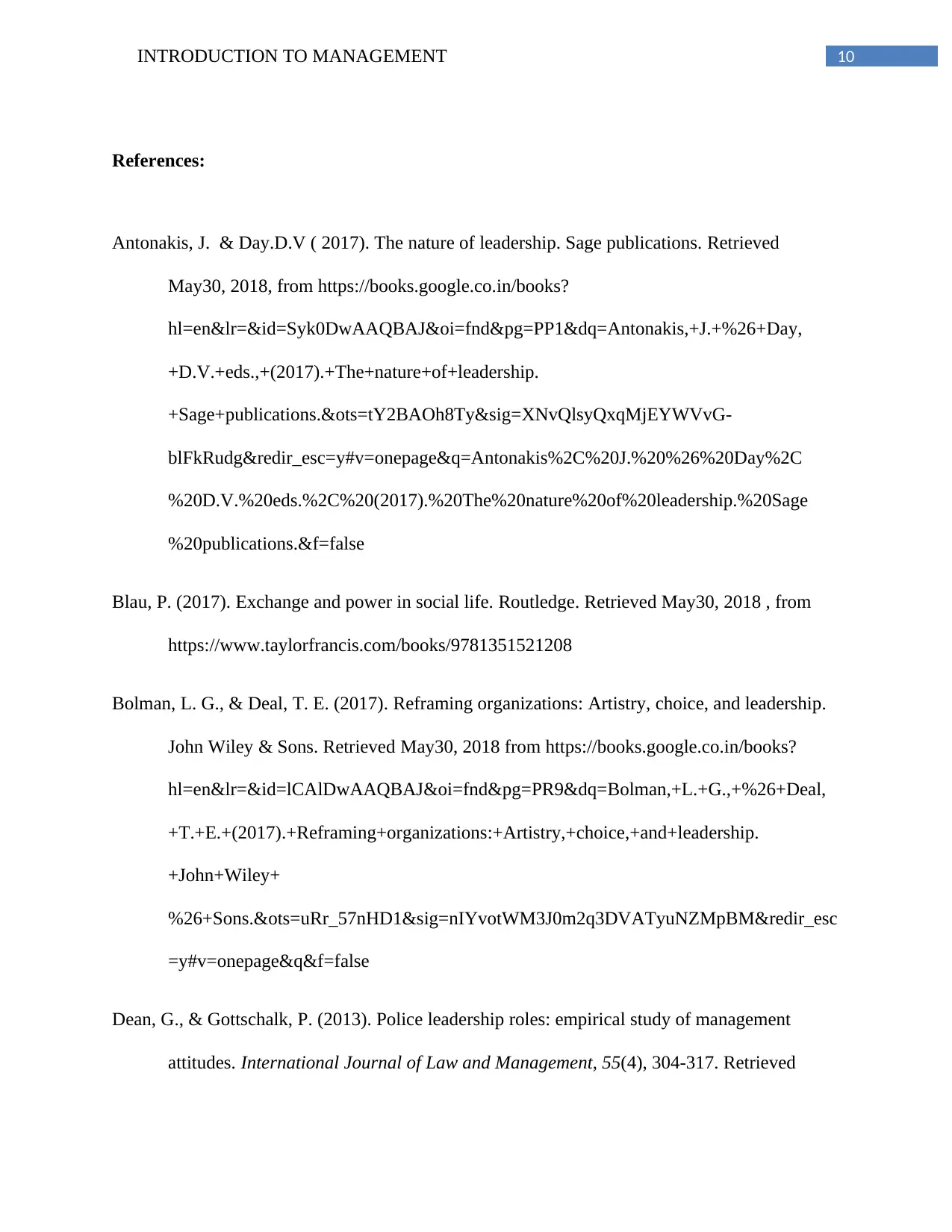
10INTRODUCTION TO MANAGEMENT
References:
Antonakis, J. & Day.D.V ( 2017). The nature of leadership. Sage publications. Retrieved
May30, 2018, from https://books.google.co.in/books?
hl=en&lr=&id=Syk0DwAAQBAJ&oi=fnd&pg=PP1&dq=Antonakis,+J.+%26+Day,
+D.V.+eds.,+(2017).+The+nature+of+leadership.
+Sage+publications.&ots=tY2BAOh8Ty&sig=XNvQlsyQxqMjEYWVvG-
blFkRudg&redir_esc=y#v=onepage&q=Antonakis%2C%20J.%20%26%20Day%2C
%20D.V.%20eds.%2C%20(2017).%20The%20nature%20of%20leadership.%20Sage
%20publications.&f=false
Blau, P. (2017). Exchange and power in social life. Routledge. Retrieved May30, 2018 , from
https://www.taylorfrancis.com/books/9781351521208
Bolman, L. G., & Deal, T. E. (2017). Reframing organizations: Artistry, choice, and leadership.
John Wiley & Sons. Retrieved May30, 2018 from https://books.google.co.in/books?
hl=en&lr=&id=lCAlDwAAQBAJ&oi=fnd&pg=PR9&dq=Bolman,+L.+G.,+%26+Deal,
+T.+E.+(2017).+Reframing+organizations:+Artistry,+choice,+and+leadership.
+John+Wiley+
%26+Sons.&ots=uRr_57nHD1&sig=nIYvotWM3J0m2q3DVATyuNZMpBM&redir_esc
=y#v=onepage&q&f=false
Dean, G., & Gottschalk, P. (2013). Police leadership roles: empirical study of management
attitudes. International Journal of Law and Management, 55(4), 304-317. Retrieved
References:
Antonakis, J. & Day.D.V ( 2017). The nature of leadership. Sage publications. Retrieved
May30, 2018, from https://books.google.co.in/books?
hl=en&lr=&id=Syk0DwAAQBAJ&oi=fnd&pg=PP1&dq=Antonakis,+J.+%26+Day,
+D.V.+eds.,+(2017).+The+nature+of+leadership.
+Sage+publications.&ots=tY2BAOh8Ty&sig=XNvQlsyQxqMjEYWVvG-
blFkRudg&redir_esc=y#v=onepage&q=Antonakis%2C%20J.%20%26%20Day%2C
%20D.V.%20eds.%2C%20(2017).%20The%20nature%20of%20leadership.%20Sage
%20publications.&f=false
Blau, P. (2017). Exchange and power in social life. Routledge. Retrieved May30, 2018 , from
https://www.taylorfrancis.com/books/9781351521208
Bolman, L. G., & Deal, T. E. (2017). Reframing organizations: Artistry, choice, and leadership.
John Wiley & Sons. Retrieved May30, 2018 from https://books.google.co.in/books?
hl=en&lr=&id=lCAlDwAAQBAJ&oi=fnd&pg=PR9&dq=Bolman,+L.+G.,+%26+Deal,
+T.+E.+(2017).+Reframing+organizations:+Artistry,+choice,+and+leadership.
+John+Wiley+
%26+Sons.&ots=uRr_57nHD1&sig=nIYvotWM3J0m2q3DVATyuNZMpBM&redir_esc
=y#v=onepage&q&f=false
Dean, G., & Gottschalk, P. (2013). Police leadership roles: empirical study of management
attitudes. International Journal of Law and Management, 55(4), 304-317. Retrieved
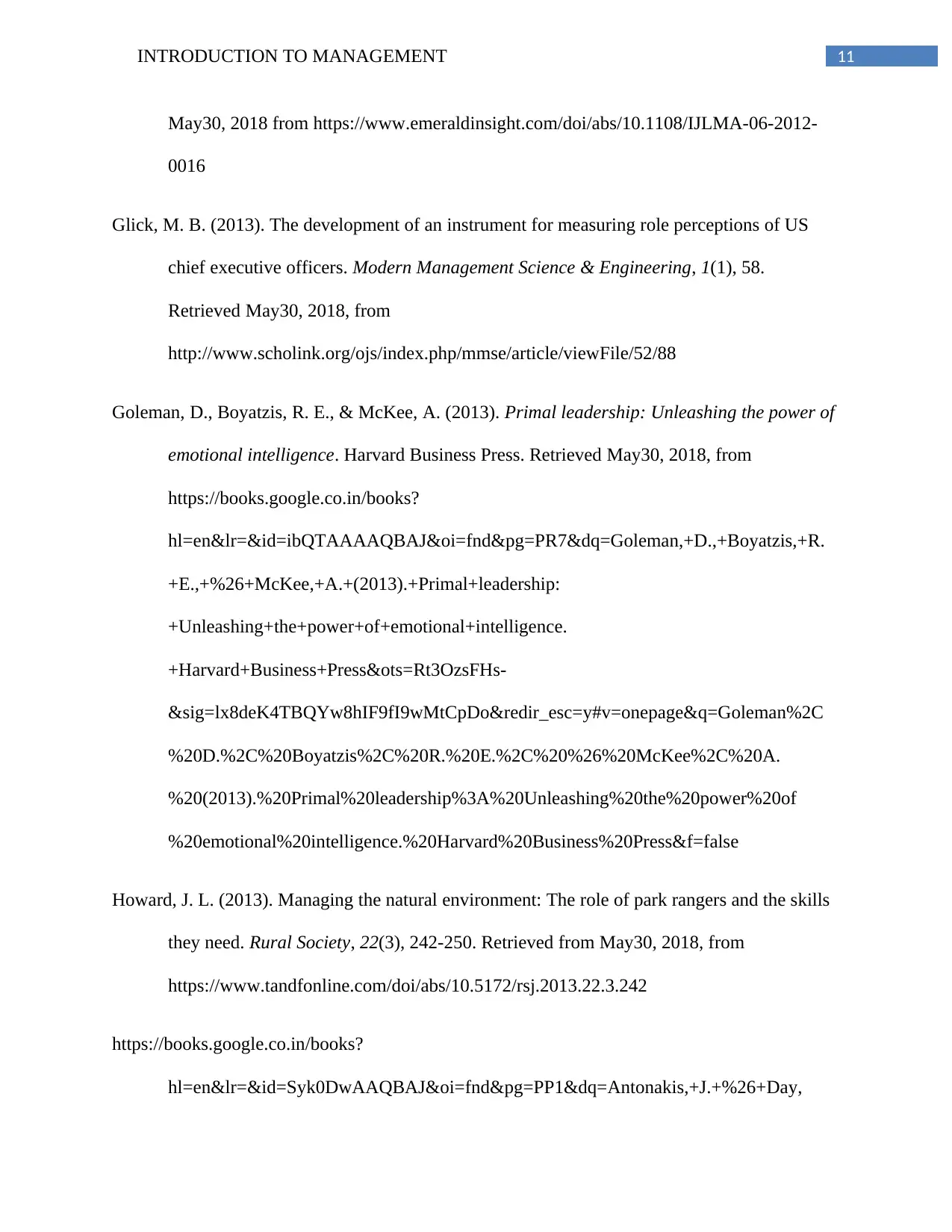
11INTRODUCTION TO MANAGEMENT
May30, 2018 from https://www.emeraldinsight.com/doi/abs/10.1108/IJLMA-06-2012-
0016
Glick, M. B. (2013). The development of an instrument for measuring role perceptions of US
chief executive officers. Modern Management Science & Engineering, 1(1), 58.
Retrieved May30, 2018, from
http://www.scholink.org/ojs/index.php/mmse/article/viewFile/52/88
Goleman, D., Boyatzis, R. E., & McKee, A. (2013). Primal leadership: Unleashing the power of
emotional intelligence. Harvard Business Press. Retrieved May30, 2018, from
https://books.google.co.in/books?
hl=en&lr=&id=ibQTAAAAQBAJ&oi=fnd&pg=PR7&dq=Goleman,+D.,+Boyatzis,+R.
+E.,+%26+McKee,+A.+(2013).+Primal+leadership:
+Unleashing+the+power+of+emotional+intelligence.
+Harvard+Business+Press&ots=Rt3OzsFHs-
&sig=lx8deK4TBQYw8hIF9fI9wMtCpDo&redir_esc=y#v=onepage&q=Goleman%2C
%20D.%2C%20Boyatzis%2C%20R.%20E.%2C%20%26%20McKee%2C%20A.
%20(2013).%20Primal%20leadership%3A%20Unleashing%20the%20power%20of
%20emotional%20intelligence.%20Harvard%20Business%20Press&f=false
Howard, J. L. (2013). Managing the natural environment: The role of park rangers and the skills
they need. Rural Society, 22(3), 242-250. Retrieved from May30, 2018, from
https://www.tandfonline.com/doi/abs/10.5172/rsj.2013.22.3.242
https://books.google.co.in/books?
hl=en&lr=&id=Syk0DwAAQBAJ&oi=fnd&pg=PP1&dq=Antonakis,+J.+%26+Day,
May30, 2018 from https://www.emeraldinsight.com/doi/abs/10.1108/IJLMA-06-2012-
0016
Glick, M. B. (2013). The development of an instrument for measuring role perceptions of US
chief executive officers. Modern Management Science & Engineering, 1(1), 58.
Retrieved May30, 2018, from
http://www.scholink.org/ojs/index.php/mmse/article/viewFile/52/88
Goleman, D., Boyatzis, R. E., & McKee, A. (2013). Primal leadership: Unleashing the power of
emotional intelligence. Harvard Business Press. Retrieved May30, 2018, from
https://books.google.co.in/books?
hl=en&lr=&id=ibQTAAAAQBAJ&oi=fnd&pg=PR7&dq=Goleman,+D.,+Boyatzis,+R.
+E.,+%26+McKee,+A.+(2013).+Primal+leadership:
+Unleashing+the+power+of+emotional+intelligence.
+Harvard+Business+Press&ots=Rt3OzsFHs-
&sig=lx8deK4TBQYw8hIF9fI9wMtCpDo&redir_esc=y#v=onepage&q=Goleman%2C
%20D.%2C%20Boyatzis%2C%20R.%20E.%2C%20%26%20McKee%2C%20A.
%20(2013).%20Primal%20leadership%3A%20Unleashing%20the%20power%20of
%20emotional%20intelligence.%20Harvard%20Business%20Press&f=false
Howard, J. L. (2013). Managing the natural environment: The role of park rangers and the skills
they need. Rural Society, 22(3), 242-250. Retrieved from May30, 2018, from
https://www.tandfonline.com/doi/abs/10.5172/rsj.2013.22.3.242
https://books.google.co.in/books?
hl=en&lr=&id=Syk0DwAAQBAJ&oi=fnd&pg=PP1&dq=Antonakis,+J.+%26+Day,
⊘ This is a preview!⊘
Do you want full access?
Subscribe today to unlock all pages.

Trusted by 1+ million students worldwide
1 out of 14
Related Documents
Your All-in-One AI-Powered Toolkit for Academic Success.
+13062052269
info@desklib.com
Available 24*7 on WhatsApp / Email
![[object Object]](/_next/static/media/star-bottom.7253800d.svg)
Unlock your academic potential
Copyright © 2020–2025 A2Z Services. All Rights Reserved. Developed and managed by ZUCOL.





